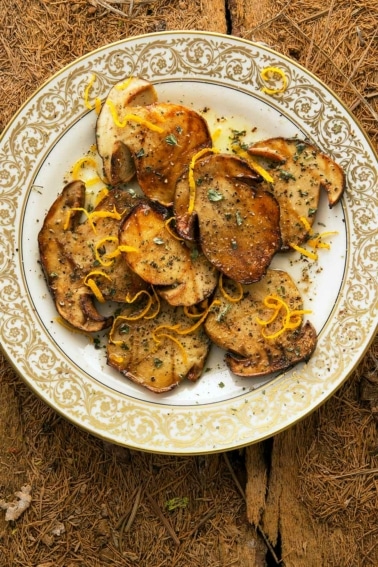Duck Heart Tartare Puttanesca
December 10, 2013 | Updated June 12, 2020
As an Amazon Associate I earn from qualifying purchases.

If there is a recipe that, over the years, has become my signature dish, it’s this tartare. I’ve made it many times, and on this epic book tour of mine, the chefs I’ve been working with have chosen to make it nearly a dozen times. So I’ve been thinking a lot about it lately.
Ironically, I first got the idea for making a duck heart tartare after I ate a similar beef heart tartare at Chef Chris Cosentino’s restaurant Incanto in San Francisco back in 2006 or so. Cosentino came up with the Puttanesca flavorings, which are basically the pantry staples of capers, olives, a little chile and tomatoes. The result is surprisingly non-threatening, taste-wise: Cool, a little sharp, a touch sweet from the tomatoes or roasted peppers, and very, very ducky. It’s one of my favorite little starters or party appetizers.
I know what you are thinking: Raw hearts? Duck hearts, especially? Ew, right? Actually, no. First off, hearts are just meat. But they are a special meat. The thing about hearts (of anything) is that they taste intensely of whatever they came out of, and duck hearts are no exception. They are also very tightly grained pieces of meat, which lend themselves to being minced fine. Perfect for a tartare.
As for hygienic concerns, I will normally use thawed hearts that had been frozen for several days (or more), just to be safe. That said, I’ve never heard of anyone getting sick or catching parasites from eating duck hearts. It’s still raw meat, however, so be sure to use only meats you really trust. That’s true for any tartare.
In winter I switch out the traditional plum tomatoes in puttanesca for roasted red pepper, stored under olive oil in a jar. I actually like it a little better than the tomatoes, as the roasted peppers have more flavor unless your tomatoes are really good.

A word to the cook: Use a very sharp knife to cut the meat for the tartare, and take your time. Do not simply hack at the hearts and hope to get them small enough for a proper tartare — they will just get stringy and nasty. You need to actually mince the hearts by hand. This is easy when making tartare for a dinner party, but will take hours if you are serving 100. Just putting that out there…
Give this a go this holiday season. If nothing else, it will certainly start conversation at the party…
Duck Heart Tartare
Ingredients
- 3 to 4 dozen duck or goose hearts, about 2/3 pound
- 1 small fresh chile, sliced very thin
- 1 tablespoon minced shallot
- 1 1/2 tablespoons tiny capers
- 1 tablespoon olives (green or black)
- 1 teaspoon finely grated lemon zest
- 2 to 3 tablespoons roasted red pepper, cut into pieces the size of the capers
- 2 teaspoons fresh squeezed lemon juice
- 2 teaspoons minced parsley
- 2 teaspoons minced mint
- Olive oil (use the good stuff!)
- Salt
- 1 large garlic clove per person
Instructions
- Trim off the top of the hearts -- the top end with the fat. Mince the hearts into pieces about the size of the capers and put into a bowl. Mince the olives well and put into the bowl. Add everything but the olive oil, lemon juice and herbs and mix gently to combine.
- Slice the garlic cloves lengthwise thinly. If you want, bring about 1 cup of milk to a simmer and add the garlic cloves. Simmer for 1 minute, then drain and pat dry -- this will take some of the bitterness out of the garlic. I do this most of the time, but not always. To finish the garlic chips, put 3 to 4 tablespoons of olive oil in a small pan and fry the garlic cloves over medium-high heat until crispy, about 2 minutes. Do not let them brown, or they will become very bitter. Drain on paper towels.
- Add the lemon juice, olive oil and herbs to the tartare and mix gently. To serve, put a large spoonful of the tartare on a plate and drizzle with olive oil, then top with garlic chips.
Nutrition
Nutrition information is automatically calculated, so should only be used as an approximation.





If sealed properly, is it okay to freeze the hearts until I have the right friends over for dinner?
Alex: That’s what I do.
Do you think this would work well with deer loin? Also, why do you add the lemon, oil and herbs last? Is that right before you serve? Lastly, on the fresh chile, is that a hot chili?
Brian: Sure, you could do it with venison loin. And yes, right before you serve. Keeps the lemon from discoloring the meat. And yes, a hot chile.
I’m having some language-issues here – by red pepper, do you mean chili or bell pepper?
Kristine: In this case, preserved red bell peppers, or other sweet pepper.
Thank you for this recipe….we have ptarmigan up here in kodiak and tartare with the dark, dark meat of the hearts is venison elevated. Amazing….
Mark: Nope. It will work fine. Mike F: Nope, but again, I see no reason why it would not work.
Have you tried this with lamb hearts, by any chance?
Love the “offal” joke. I gotta share that with my foodie friends. 😀
Would It matter if I did a combination, say goose and duck or duck and pheasant.
Michael: Yep, of course it will work! Go for it.
What would you think of this with goose hearts? I happen to have a handful…
j/k, obviously. 😮
That’s just offal.
😉